Cichlazoma: description, types and content
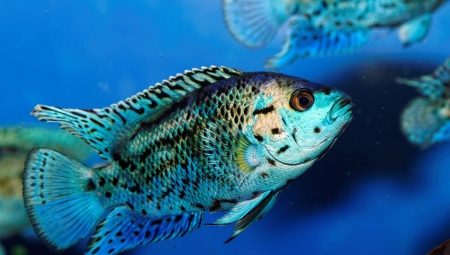
Many people are now fond of fish farming. After all, these creatures do not require special care, but at the same time they are not only pets, but also part of the interior of a house or apartment. An aquarium with colored fish is a wonderful decoration for any room. Among all the fish, many are noted with cichlase, of which there are more than 100 species. All of them are very colorful and unpretentious in content.
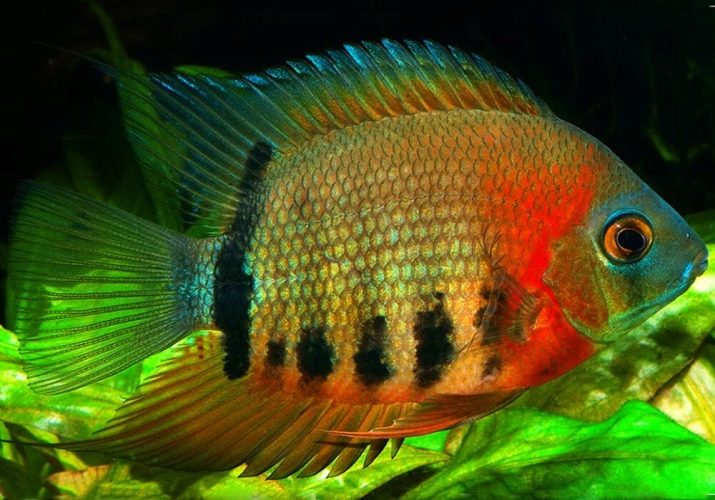
Peculiarities
Cichlazomas belong to a group of fish from the cichlid family, and they are also called ray-finned. Many of this species are considered true carnivores. Indeed, in their natural environment, they eat small fish. Some aquarium fish tend to take care of their offspring. In addition, if one of the fish encroaches on an already occupied territory, then at the same hour it will be expelled.
All cichlazomas have high intelligence. But at the same time, they differ from each other in unequal sizes, as well as colors.
In their description there is a stamp "vertebrates". Some subspecies are already on the verge of extinction. Their maintenance requires a huge aquarium, as well as the correct selection of "neighbors".
In their natural environment, they live in the waters of the United States. Cichlazomas are distinguished by excellent health. After all, their body is covered with a rather dense shell, respectively, pathogenic microorganisms very rarely get under the skin.
If we talk about describing the appearance of the fish, then the elongated body of the cichlazoma is a solid muscle. The mouth of such fish occupies most of the head, on which convex eyes and gill openings are also located. If the fish gets a wound somewhere, it will recover very quickly.
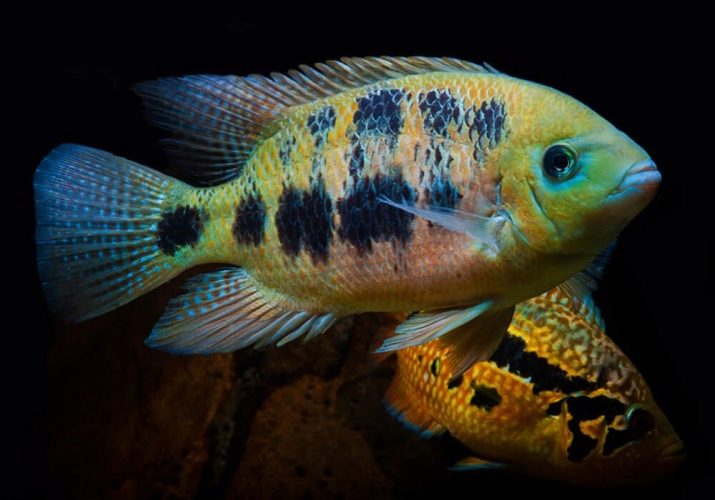
Varieties
There are quite a few varieties of cichlaz, some of which are very popular with fish lovers.
Wine or hawk
Another name for such fish is emerald. The Amazon River is considered their homeland. The body length reaches 20 centimeters. The color of wine cichlases is green-brown, with a golden or red sheen. A dark streak runs through the entire body, which at times disappears. In addition, there is a huge black spot in its very center.
The fins of the fish are yellow. Males are always slightly larger than females. They are peaceful in nature. Therefore, they can coexist with many of the same peace-loving fish. For their maintenance, you will need an aquarium, the volume of which must be at least 120 liters.
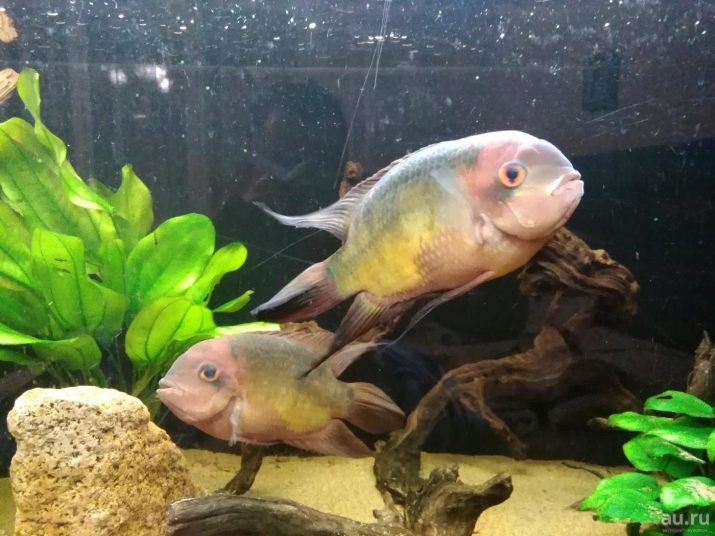
Lemon or citron
Lake Managua is considered its natural habitat. The body is gray-yellow or gray-blue in color. In addition, there are several dark stripes on the sides. By their nature, the fish of this subspecies are quite aggressive, especially at a time when spawning begins. A huge aquarium is required to keep them. In addition, only the same fish can be their neighbors.

Mesonout
The homeland of these fish is the rivers of Paraguay. This species is quite peaceful, to some extent even shy. Therefore, in the vicinity of them, the same fish or slightly smaller ones can live. Males are distinguished by a brighter color, as well as a large size. An aquarium with a volume of 100 liters is sufficient for their placement.
Salvini
Fish of this species live in the eastern part of Central America. Their color is dark green or brownish yellow. From the very head to the tail there is a dark stripe. The same dark spot is located in the middle of the body. On the back, the fin is colored blue-green, its edge has a red edging. Salvini's tail is clay-yellow.
Males of this subspecies are colored more brightly, while females have a black spot on their gills. The male grows up to 15 centimeters, and the female - up to 13 centimeters. By their nature, the fish are quite peaceful, but during spawning they become very aggressive. It is worth buying a large aquarium for them - at least 250 liters in volume.
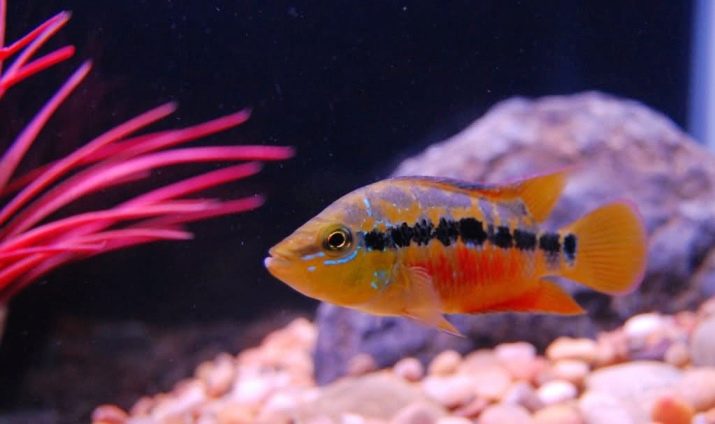
Cuban
Fish of this type live in the rivers of Barbados. They grow in length up to 20 centimeters. The color is variable, it can change depending on their age or mood. Most often, a lot of streaks or spots can be seen against a green background. Males have slightly pointed fins and a fat pad on their foreheads.
They have a rather aggressive temperament, so they like to live in an aquarium without neighbors of a different species.
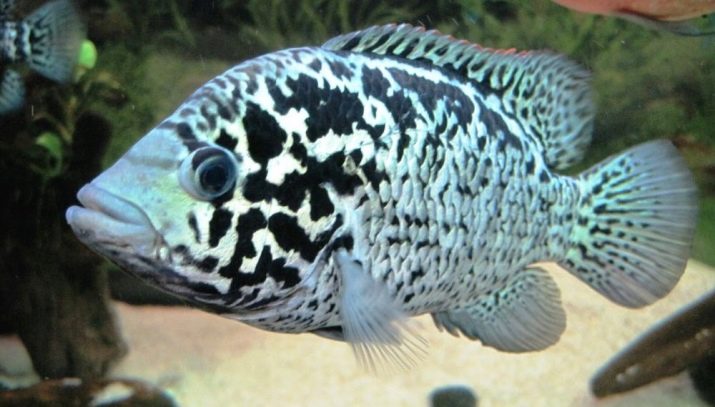
Eliot
This type of fish is beautiful. You can see them in the rivers of Mexico, where they stick together, mainly in shallow water. When the mating period begins, couples almost always stick together. Besides, they jealously guard their territory... Therefore, in aquariums, it is imperative to distribute the bottom into zones so that couples can protect the territory they have chosen as their own. The aquarium for such fish should be at least 100 liters.
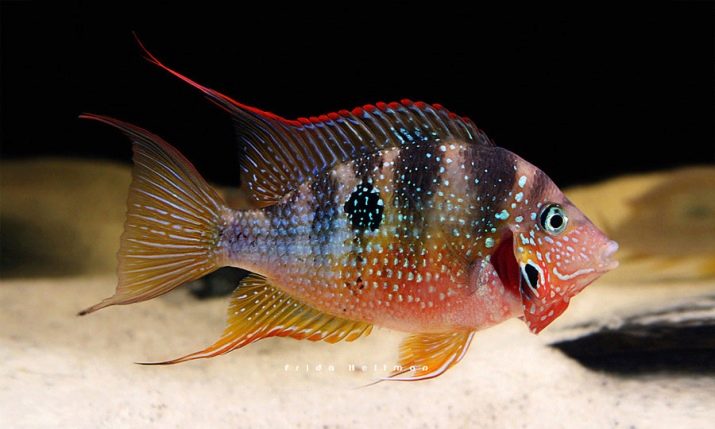
Managuan
This cichlazoma has a powerful body and a rather bright color. People call it a jaguar, since this color is quite similar to this animal. They grow up to 40 centimeters, so the aquarium should be at least 500 liters. In addition, the neighbors must be no smaller in size, otherwise they are simply eaten for breakfast.
By their nature, they are calm, but they will strictly guard their territory. Females are slightly smaller in size than males, and it is on this basis that they are identified.
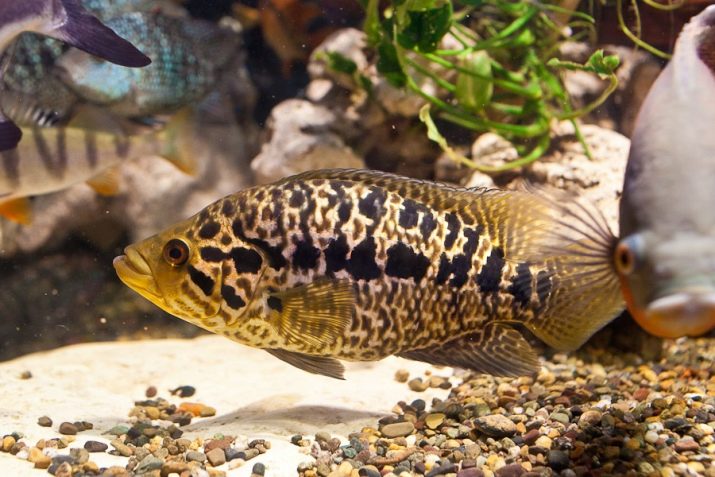
Black stripe or pearl
They live in the lakes of Guatemala and can grow up to 10 centimeters, but in aquariums they are slightly smaller. Their color is gray. The base is decorated with several stripes located all over the body. The fins are green. It doesn't take too much hassle to maintain them. Their character is quite calm.
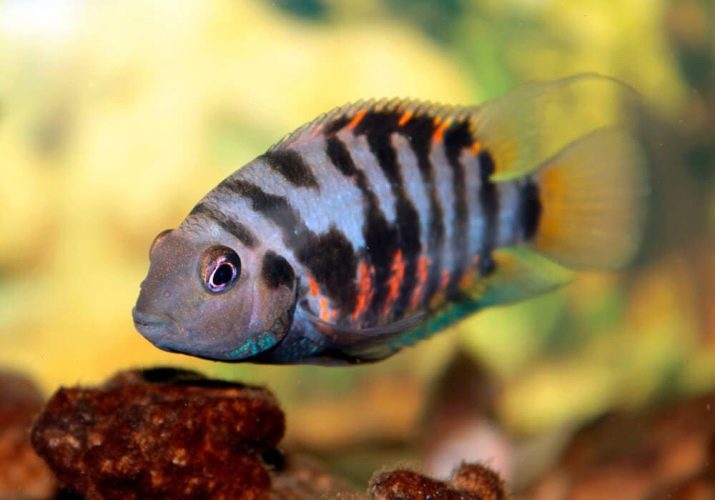
Rainbow
Fish of this subspecies are quite large and can grow up to 20 centimeters. Their body is slightly elongated, and the sides are flattened. The head is rather large, with protruding eyes and a huge mouth. Their color is most often red, green or orange. In addition, the entire body of the fish is covered with multi-colored spots. The fins as well as the tail have a black edging.
By nature, they are peaceful and can coexist with different types of fish. For maintenance, you will need an aquarium with a size of at least 350 liters.
Flower horn
This species of aquarium fish appeared in 1996 as a result of crossing rainbow and lipped cichlases. However, there is a lot of disagreement on this point. They are rather large fish with a pink or red tint. They grow up to 35 centimeters in length. On the body there is a strip that runs from head to tail, as well as spots that resemble hearts in their shape. Their life expectancy is up to 10 years. The female and the male are almost the same, so it is impossible to distinguish between them.
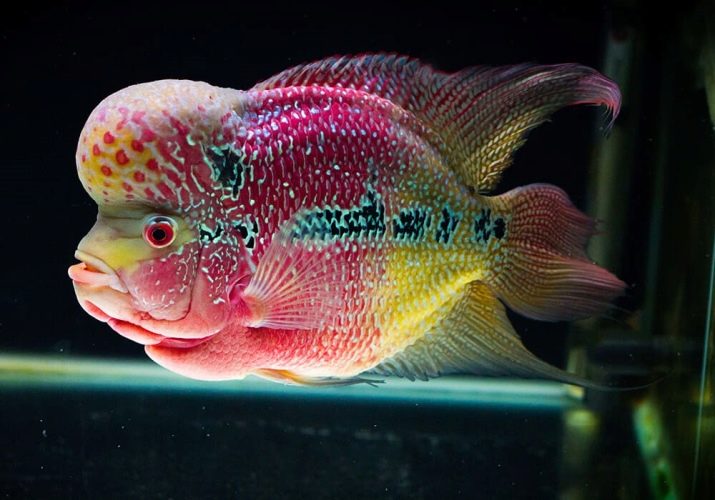
Blue Dempsey
This type of fish appeared as a result of breeding work with eight-striped cichlazomas. They grow up to 20 centimeters in length. Their body is dark brown in color with a lot of blue specks. In good conditions, they will live up to 15 years.
Festa
Many people call the orange cichlazoma the "red terror". After all, it has a rather aggressive character, so it is recommended to keep it in aquariums separately from other fish. The volume of the aquarium must be at least 300 liters. Females grow up to 13 centimeters in length, and males up to 19 centimeters. Festa is striped with black and orange stripes. In addition, there are also many specks on her body.
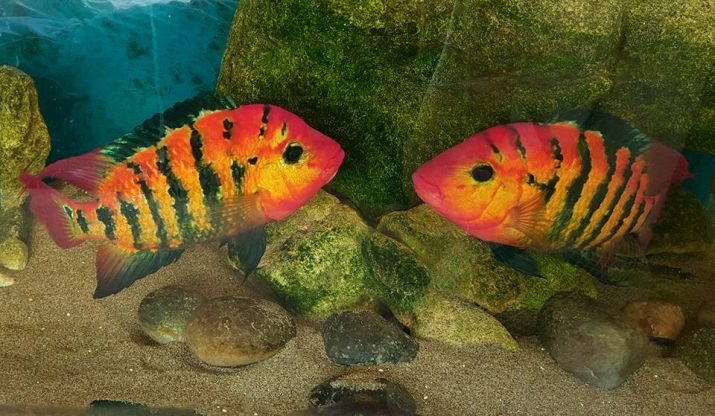
Labiatum
These fish are large in size, sometimes they grow up to 40 centimeters in length. They are painted bright orange or yellow. Live up to 14 years old. They have a rather aggressive character. It must be kept in aquariums with a volume of at least 200 liters.
Carpinte red texas
This subspecies does not occur in nature, but was born as a result of crossing the pearl cichlazoma with the flower horn. They have a rather aggressive character. Therefore, they must be kept separately. They are painted red with white dots.
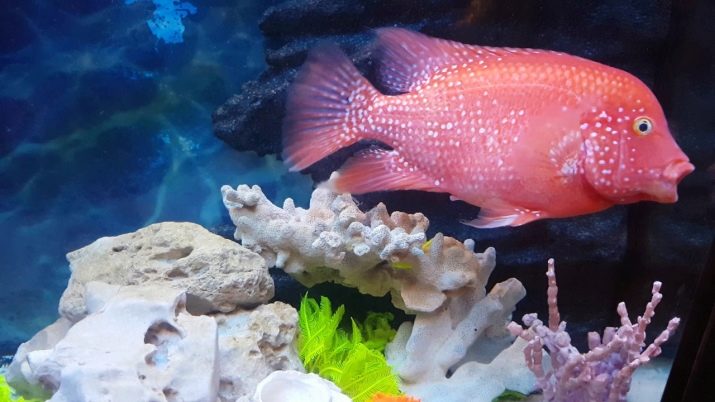
Tsikhlazoma Sedzhik
A small fish, up to 10 centimeters in length, has a rather calm character. Her body is colored brown, and her fins are yellow. There are stripes on the sides.
Red-throated or vieja
She lives in the waters of Guatemala. Its length reaches 30 centimeters in males and up to 24 centimeters in females. There is a wide black stripe in the very middle of the body. In addition, black specks can be seen all over the back. The chest is painted red, which is why it got its name.
Multispinosa
This is one of the most peaceful fish of this subspecies. She is quite curious and sociable, can coexist with various other fish. Her color is yellow, so she immediately makes her draw all the attention of others. However, there is a blue stripe on the back and sides. The fins and tail are edged in blue. The fish grows up to 16 centimeters in length, so an aquarium with a volume of at least 250 liters will be required for maintenance.
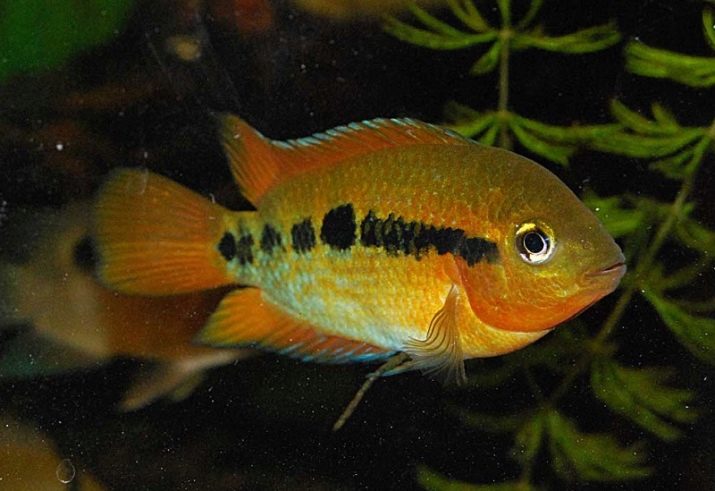
Nannakara
It differs from other fish in its neon blue color. The dorsal fin has a golden strip that runs along the very edge. Nannakars grow up to 15 centimeters, but their life expectancy is only 5 years. Their character is quite peaceful.
Bocura
They live in the waters of Mexico or Guatemala. They grow in length up to 20 centimeters. Their main color is yellow or orange. There are huge dark spots along the back, and the fins have a raspberry or turquoise tint. Bokura has an aggressive character.
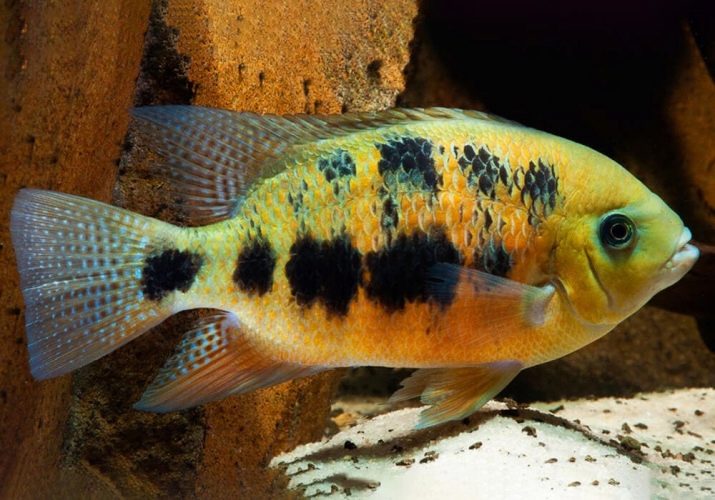
Dovey
It is one of the largest aquarium fish and grows up to 50 centimeters in length. Adults can weigh up to 7 kilograms. The color can be gray-silver or gray-yellow. There are a large number of blue-black spots on the body. There is a dark stripe along the back. The aquarium for their maintenance must be at least 750 liters.
Eight lane
Such fish live in the waters of the Amazon River. Their length reaches 20 centimeters. The color can be yellow or brown, in some cases even black. There are several black transverse stripes all over the body. On the tail, as well as in the middle of the body, there is a black spot with a gold border. The temperament is quite aggressive, so it is best to keep them separate from other fish.
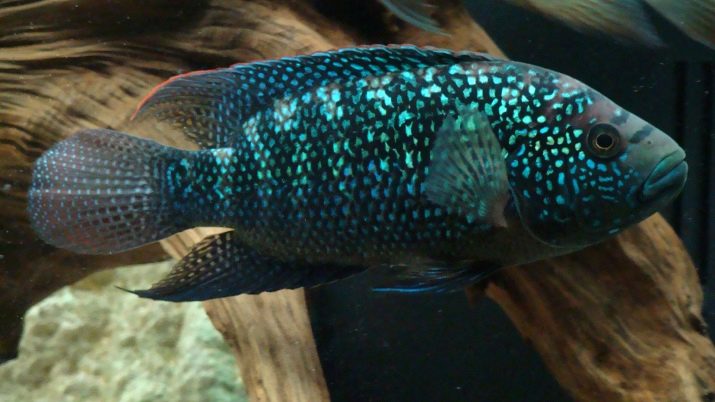
Compatibility
It is impossible to generalize all types of cichlases. However, it is worth noting that, by their nature, almost all of them have an aggressive character. She will defend her territory, especially during the spawning season.
Tsichlazoma can coexist only with large fish, but it will simply eat smaller individuals.
For convenience, it is necessary to zone the bottom with flat stones.
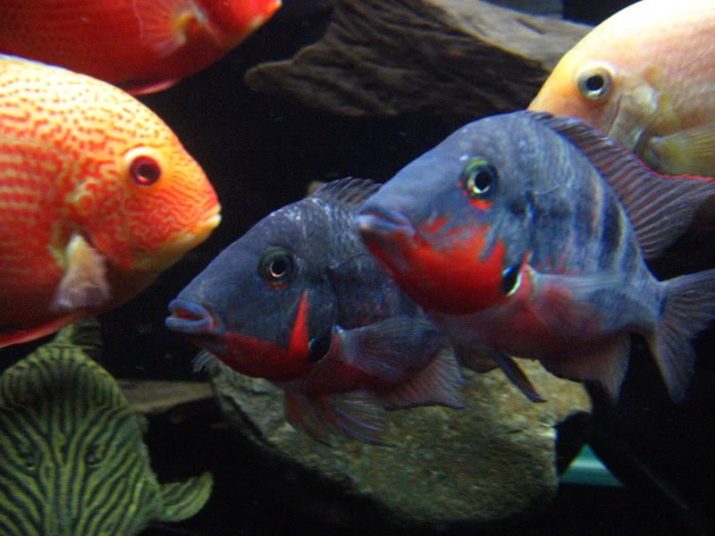
Growing conditions
In the natural environment, all cichlazomas live in pairs. Therefore, those who decide to have such handsome men for themselves need to take care of the partitions. One aquarium can contain from 2 to 3 pairs of fish. Each of the couples should have their own personal space.
They lay eggs on stones. And since they all have a highly developed parental instinct, you should not bother them during this period. In addition, inside the aquarium itself, it is necessary to create conditions that will be closer to the natural environment. It is necessary to spread as many stones as possible along the bottom, as well as snags, so that the fish can hide. In addition, you need to buy algae with a well-developed root system, or simply spread artificial greenery at the bottom.
The temperature of the water in the container should not be lower than +20 degrees Celsius, moreover, not too hard and acidic. You will need to install lighting that must be on all the time. But at the same time it is necessary to protect the aquarium from direct sunlight. It is imperative to make out the newly-made couple in time and immediately move it out.
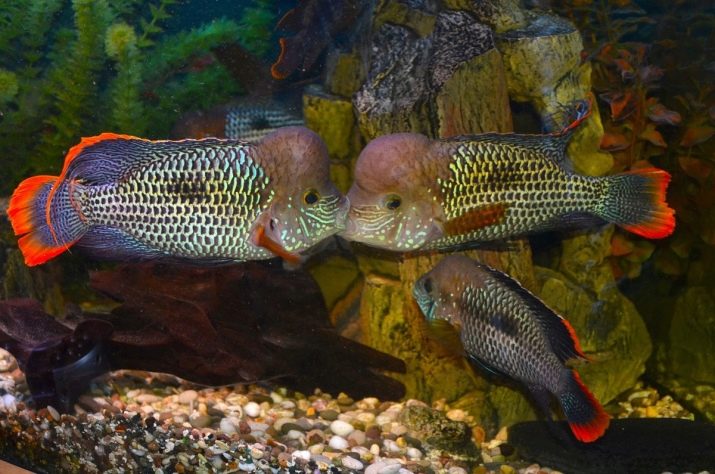
Proper nutrition
Since cichlazomas are by nature predators and are considered omnivores, they have no particular preferences in food.
It is best to feed your fish a plant-based food that can be granulated or flaked.
Besides, the diet may contain worms, seafood... In percentage terms, this is 30 percent vegetation and 70 percent proteins. And you can also give your wards minced poultry meat cooked with your own hands.
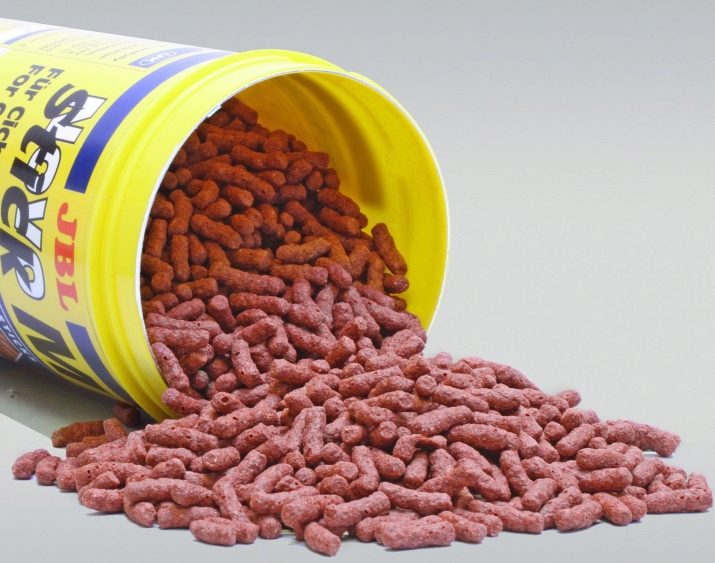
Sexual characteristics and reproduction
Cichlazomas become mature only by 1 year of their life. Therefore, by this time it is necessary to acquire at least one pair of fish. In their natural environment, females lay eggs in a substrate, and in an aquarium, on stones. Then they find the most secluded spot in the ground. They clean it from dirt, and also slightly expand. It is intended for fry. Fish lay from 150 to 350 eggs at a time. After that, for one week, they guard the eggs, replacing each other at the post. At this time, they fan the laid eggs with their fins to enrich them with oxygen.
When babies are born, they are moved to a prepared pit, and then they are guarded for up to 30 days. Any appearance of a stranger will be perceived with militant aggression. To attack other fish, parents use their fins, which they wave very quickly.
After one month of their life, you can begin to feed the fry. It is best to use starter feed for this. These can be both powders and suspensions. You should not give the babies crushed flakes right away, as this can lead to the death of the entire new brood.
Summing up, we can say that almost all cichlazomas are similar to each other in nature, as well as in habits. However, their appearance is completely different.Therefore, before purchasing such beauties, you should definitely familiarize yourself with each individual variety. You can pick it up by the color you like, as well as by their size. After all, not every person can afford to put a large aquarium in the room. But in general, if you follow all the rules and keep the fish in good conditions, then they will only delight the eye and fill the soul with peace.
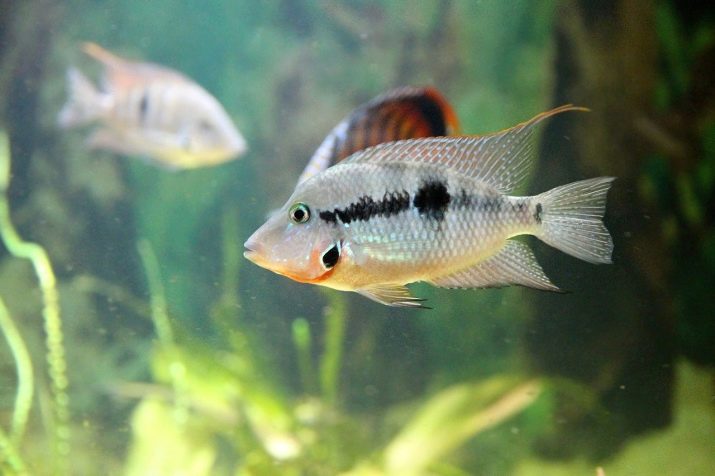
For information on how to keep, breed and feed fish in an aquarium, see the next video.








